Years after its premiere, the Raspberry Pi continues to enjoy enormous popularity. No wonder, since the affordable mini-PC is not only suitable as a Linux computer and for learning programming languages, but also for countless projects such as an inexpensive media center PC, a NAS solution or a self-hosted cloud. But enthusiasts in particular sometimes wish that the Raspi could do a little more. The Raspberry Pi Foundation has set itself the task of keeping the costs for the Pi at a consistently low level. As a result, the Raspberry Pi hardware can become a bottleneck for demanding projects. For example, the built-in memory with one gigabyte of RAM is too tight for the desktop use of Linux or even Windows 10.
Raspi alternatives: Especially interesting for hobbyists
The market for so-called “ single board computers” ”(SBC), ie single-board computers like the Raspi, has literally exploded in recent years. Names like Orange PI, Banana Pi or Odroid advertise better performance and more functions. At least in theory this is also true: Many Raspi opponents offer better components or more connections, for example for SATA hard drives. However, the hardware superiority is often offset by a more complicated software experience. While there are countless ready-to-use operating system solutions for the Raspi, along with a correspondingly large amount of community support, the more exotic alternatives usually require more effort and training. The selection of available operating systems is usually not that extensive. A good desktop Linux is available for all the Pi alternatives presented.General Linux solutions such as Ubuntu or Arch Linux run on almost all Pi alternatives - and often even better than on the "original". Also special projects like that The Batocera emulator system is increasingly being adapted for other SBCs. Nevertheless: If you want it easy, there is still no way around the Pi.
Rock Pi 4
The Rock Pi 4 provides a quite fresh alternative to the Raspberry Pi 4. The SBC justifies the comparatively high price of around 100 euros with modern components: The built-in Rockchip processor RK3399 with its six cores delivers significantly more raw power than the Pi, and more he relies on modern 64-bit architecture. The Rock Pi is also available in model variants with up to 4 gigabytes of RAM, which also enables more demanding applications. The Rock Pi 4 also outperforms the current Pi competition in other ways. For example, it offers the option of expanding the memory not only with a microSD card, but also with an eMMC module or even an M.2 SSD. Two of the four USB plugs support faster data transfer via USB 3.0, and fast AC WLAN and Bluetooth 5.0 are also included in the more expensive models of the Rock Pi 4.
In fact, the Rock Pi 4 is one of the most interesting upgrade options for the Raspberry Pi. The software support for the relatively young SBC is already quite good: In addition to Ubuntu Server and Debian Desktop, there are also versions of Android, Android TV and the Kodi distribution LibreELEC ready for download: https://wiki.radxa.com/Rockpi4/downloads
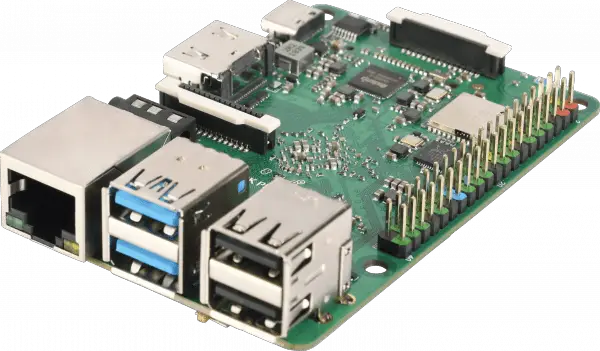 The Rock Pi 4 is one of the most interesting Raspberry Pi alternatives.
The Rock Pi 4 is one of the most interesting Raspberry Pi alternatives. Asus Tinkerboard S
The first version of the Asus Tinkerboard caused a sensation in 2017: the trip by the component specialists to Raspi was a surprise for many. In fact, the Tinkerboard offered significantly more powerful hardware than the Raspberry Pi competition at the time, but could not fully convince itself of the software support. In the meantime, not only has the OS situation improved, ASUS has also added a stronger variant of the SBC with the Tinkerboard S.
Driven by the QuadCore SoC Rockchip RK3288 and a Mali T760 GPU, the Tinkerboard S offers more performance than the current Raspis. The ASUS SBC also comes with 16 gigabytes of eMMC memory on which the operating system can be installed. Apart from that, it offers WLAN, Bluetooth 4.0, four USB ports (unfortunately only with USB 2.0) and, like the Raspi, 40 GPIO pins. That Tinkerboard-Forum now offers a large selection of software projects, including Android-based distris for the ASUS SBC..
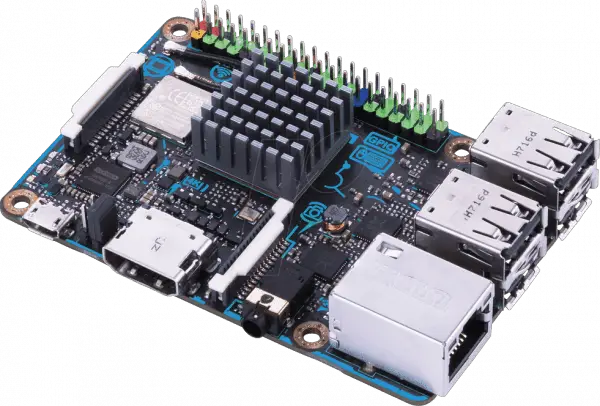 After a rather bumpy start, the ASUS Tinkerboard S is now an interesting Pi alternative.
After a rather bumpy start, the ASUS Tinkerboard S is now an interesting Pi alternative. Banana Pi M3
Various Chinese companies have been supplying interesting alternatives to the Raspberry Pi under the name Banana Pi for several years. The Banana Pi M3, released in 2016, comes from Sinovoip and is still a very interesting Pi alternative. Its Allwinner A83T processor delivers eight cores that clock at up to 2 gigahertz. It is flanked by 2 GB of RAM and 8 gigabytes of internal memory for operating systems. On paper, the Banana Pi delivers significantly more power than the original.
In practice, however, the M3 tends not to be able to bring its performance to the floor because the CPU cores throttle quickly under load - but the performance of the Banana Pi is still ahead of the Raspi. In addition, the software support is not quite as abundant compared to the Raspberry Pi. However, if you are interested in the Sinovoip computer, you will find some well-functioning distributions in the Banana Pi Wiki , including Ubuntu and Android.
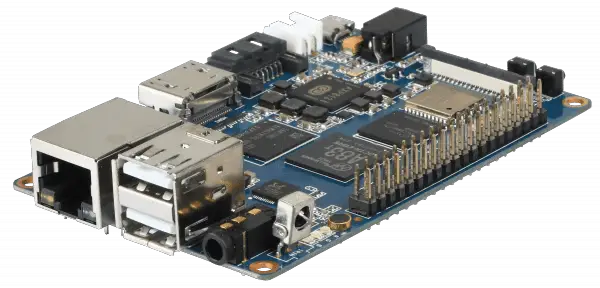 The Banana Pi M3 delivers more raw power than the Raspberry Pi.
The Banana Pi M3 delivers more raw power than the Raspberry Pi. ODROID-N2
Hardkernel has also been in business for a long time with its Odroid series. Contrary to what the name might suggest, the Odroid SBCs not only work with the Android operating system, they also offer good Linux support. The Odroid N2 is the youngest and so far strongest entry in the Odroid portfolio. It comes with a 6-core Amlogic processor with either 2 or 4 gigabytes available. Compared to the Raspberry Pi, the Odroid N2 is a good bit larger and comes with a passive cooler ex works. Like practically all more expensive alternatives, it is possible to control both the four USB 3.0 ports and the Gigabit Ethernet port with full bandwidth. Especially for network projects, such as the operation of a NAS solution,the Odroid N2 is therefore potentially more suitable than the current Raspberry Pi models. On the software side, stable versions of are already available at the start of the Odroid N2 Ubuntu 18.04 and Android 9 “Pie” , but further OS versions shouldn't be too long in coming..
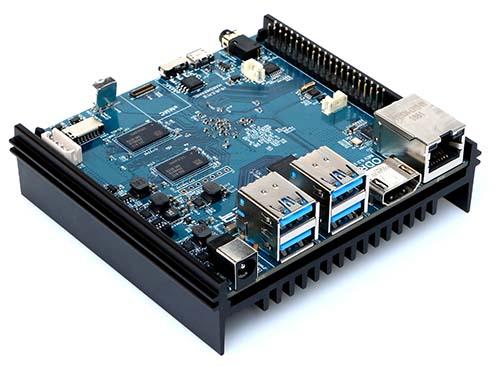 The Odroid N2 is the most powerful Odroid SBC to date.
The Odroid N2 is the most powerful Odroid SBC to date. Atomic Pi
It doesn't always have to be ARM! While most Pi alternatives rely on the ARM architecture, the Atomic Pi offers an x86 processor, more precisely an Intel Atom x5-Z8350. It's no longer brand new, but ensures that Windows runs on the Atomic Pi in addition to Linux. Especially in desktop use, the Atom is significantly faster than comparable SBCs in many applications. An Ubuntu derivative is already preinstalled on the 16 gigabyte internal memory, other operating systems can be loaded from an SD card or via USB if desired. However, you have to do without an m2 SSD connection. Otherwise, the Atomic Pi offers two gigabytes of RAM, Bluetooth 4.0, AC WLAN and two USB-3 and USB-2 ports. Digital Loggers offers the Atomic Pi in direct sales at. With a price of 34 US dollars for the basic board, it is on a similar price level as the Raspberry Pi and should therefore represent a highly interesting alternative.
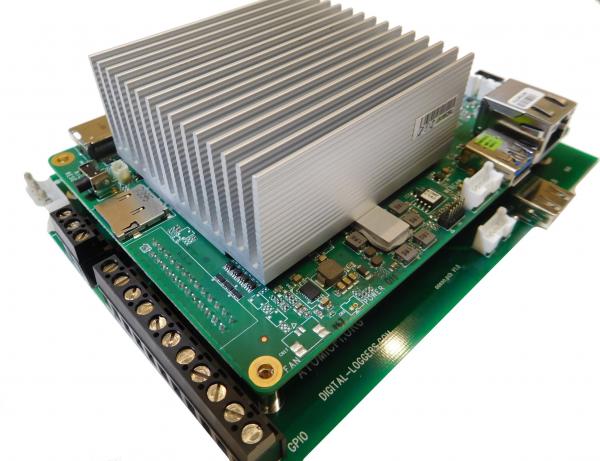 The Atom processor on the Atomic Pi requires a large heat sink, but also performs significantly more than Raspi and Co.
The Atom processor on the Atomic Pi requires a large heat sink, but also performs significantly more than Raspi and Co.